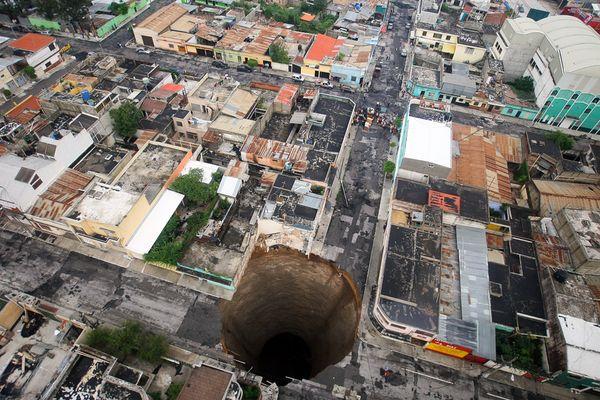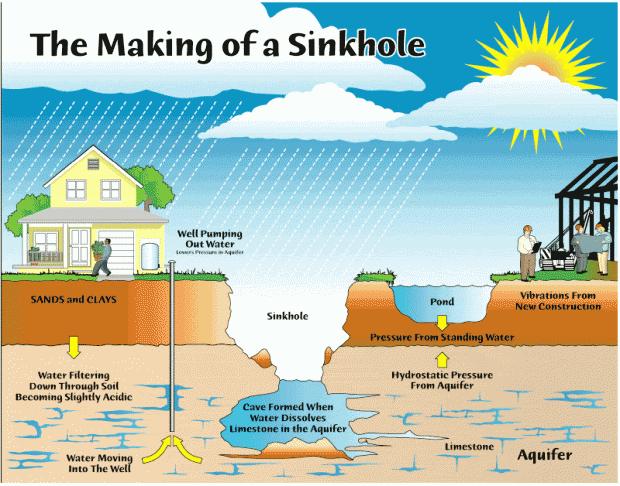Sinkholes
A common emotion in many novels is wishing that the ground would open up and swallow the person whole. While it makes for great literary drama, it can be terrifying the same happens in real life. Imagine standing on solid ground one minute and tumbling down a deep hole the other. That is a reality experienced by those who have fallen into sinkholes. These holes open up suddenly, without any indications of what is to happen. Understanding how such a hole can appear without any warning may seem difficult, but in fact is quite simple.
Sinkholes are found all over the world. In the U.S., sinkholes are especially common in Texas, Alabama, Missouri, Kentucky, Tennessee, Pennsylvania, and Florida, according to the U.S. Geological Survey.

Causes of Sinkholes
Sinkholes can be natural or man made. Natural sinkholes occur due to erosion or underground water. They start developing long time before it actually appears. The ground beneath our feet is not as much of a solid structure as we think it is. The ground is made from dirt, along with many rocks and minerals. There is water continually seeping in between the mud, rocks and minerals, as it makes its way down to the ground water reservoirs. As this happens, the water slowly erodes the rocks and minerals. Sometimes the flow of water increases to a point when it washes away the underground structure of the land. And when the structure becomes too weak to support the surface of the earth, it collapses and opens up a hole. This is how sinkholes are formed.
Humans are also responsible for the formation of sinkholes. Activities like drilling, mining, construction, broken water or drain pipes, improperly compacted soil after excavation work or even heavy traffic can result in small to large sinkholes. Water from broken pipe can penetrate through mud and rocks and erode the ground underneath and cause sinkholes. Sometimes, heavy weight on soft soil can result in collapse of ground, resulting in a sinkhole. Sinkholes can also form when the land surface is changed.
Areas that have a bedrock made of limestone, salt deposits or carbonate rock are most susceptible to erosion and the formation of such holes. These rocks tend to erode as acidic water passes through them. When rainwater passes through decaying plant debris, it tend to become more acidic. Over a period of years, overlying sediments collapse and a sinkhole develops. Sometimes the holes are small, measuring a few feet wide and ten to fifteen feet deep. Others can be hundreds of miles wide and deep. However, all of them can be dangerous for those that get caught in them. There are three major kinds of sinkholes. Their formation is determined by the same geological processes, barring a few differences.
Types of Sinkholes
The three major types of sinkholes know to us are : Solution, Cover Collapse and Cover Subsidence.
1. Solution sinkholes are most commonly seen in areas that have a very thin cover of soil on the surface, exposing the bedrock below to continual erosion by water. As the water percolates through the bedrock, it carries away small parts of the rock with it. As the bedrock erodes, particles collect in the spaces it leaves. Over a period of time, a small depression is formed. It is at this point where the hole forms. The hole is usually bowl shaped and can be quite large. Sometimes the bedrock may collapse all of a sudden to form such a solution sinkhole and other times it happens over time.
2. The second kind of sinkholes are known as Cover Collapse sinkhole. These take place when the bedrock is covered by a deep layer of soil and earth. Once the bedrock begins to get eroded, crack start forming in the rocky areas around it. When this happens, a number of weak points begin to form in the layers of soil and strata above it. Finally, it comes to a point when the weak points become a large hole within the bedrock that cannot support the weight above it. The cover collapse usually happens in a sudden manner and can create large holes in a matter of minutes.
3. The last kind of sinkholes are known as Cover Subsidence Sinkhole. In this case, the hole is formed over a period of time. The bedrock here is covered by soil and materials which are not well knitted together. Areas that have soil comprising largely of clay or sand often face the occurrence of this hole. Once the bedrock starts to erode, the clay or sand starts permeating through the cracks and settles into the spaces left behind. Over time, this creates a cavity on the surface of the soil and not under it.

Effects of Sinkholes
The effects of a sinkhole vary depending on where and how it was formed. Natural sinkholes can form on land and in the ocean as well. When they are formed on land, they can change the general topography of the area and divert streams of underground water. If they form suddenly in areas with heavy population, they can cause a lot of damage to human life and property. Some holes are formed due to the leak in underground storm drains and sewer systems. When they collapse, the damage can be seen for many miles due to the repairs that become necessary.
They can be dangerous to the foundations of the building. Toxic chemicals beneath the earth can come up and may pollute the groundwater. Sinkholes occur commonly in Florida as the state has many underground voids and drainage systems carved from the carbonate rocks.
Natural sinkholes cannot be prevented, as they are bound to occur. However, the ones caused due to human negligence can be prevented in time. Practices such as maintaining the underground systems and plumbing are the best to make sure that a sudden deep hole does not appear in the middle of a city!
References
http://earthsky.org/earth/what-causes-sinkholes
http://kids.discovery.com/tell-me/curiosity-corner/earth/natural-disasters/what-causes-sinkholes
http://science.howstuffworks.com/nature/natural-disasters/sinkhole.htm

